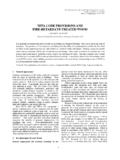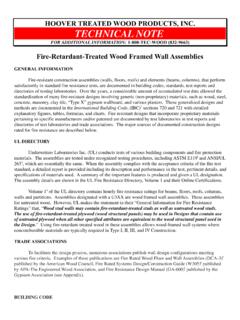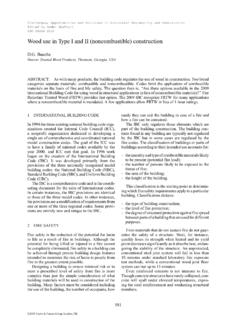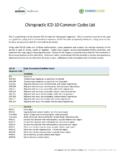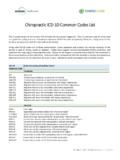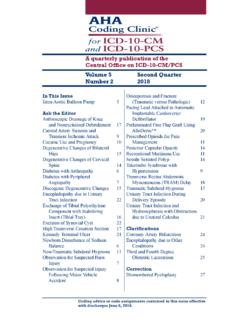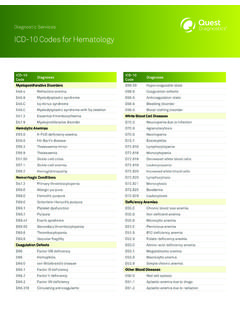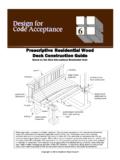Transcription of NFPA CODE PROVISIONS AND FIRE-RETARDANT-TREATED …
1 New Developments in Structural Engineering and Construction Yazdani, S. and Singh, A. (Eds.) ISEC-7, Honolulu, June 18 23, 2013 1 nfpa code PROVISIONS AND FIRE-RETARDANT-TREATED WOOD DAVID G. BUECHE1 1 Hoover Treated Wood Products, Thomson, Georgia, USA It is generally recognized that there is really no such thing as a fireproof building. Fires can occur in any type of structures. The severity of a fire , however, is contingent on the ability of a construction to confine the fire , limit its effect on the supporting structure, and control the spread of smoke and gasses. Building construction and life safety codes are concerned with the types of materials used in buildings. Their concern is rooted in risk posed by fire to the structure and persons using it. Both aim to reduce property loss and protect life safety. This paper examines these National fire Protection Association ( nfpa ) codes and their referenced standards. It specifically addresses how FIRE-RETARDANT-TREATED wood (FRTW) can be used in building construction and examines a few case histories demonstrating the use of FRTW in lieu of noncombustible building elements.
2 Keywords: FIRE-RETARDANT-TREATED wood, fire resistance, Component additive method, nfpa Codes, Types of construction 1 General Appearance Building construction and life safety codes are concerned with the types of materials used in buildings. Their concern is rooted in risk posed by fire to the structure and persons using it. Both aim to reduce property loss and protect life safety. Conceptually however, the codes are very different in scope. The Life Safety code ( nfpa 101) primarily addresses construction, protection, and occupancy exiting features necessary to minimize the danger to life from the effects of fire as well as conditions associated with non- fire emergencies. The Building Construction and Safety code ( nfpa 5000) addresses a wide range of considerations, including structural strength, stability, sanitation, means of egress, adequate light and ventilation, and energy efficiency.
3 Both nfpa 5000 and nfpa 101 incorporate a holistic implementation of fire protection and life safety requirements within the scope of each code . As a result, applications for combustible materials, such as wood, are limited, especially in unsprinklered and larger multistory structures. These codes and their referenced standards recognize the benefits of pressure impregnating fire retardants into wood. FIRE-RETARDANT-TREATED wood (FRTW) does not require water or electricity to protect the wood and therefore provides passive protection. When properly installed according to code requirements, FRTW never needs additional inspection or service and is free of these ongoing maintenance costs. 2 FIRE-RETARDANT-TREATED Wood Pressure impregnated fire retardant treatments do not prevent wood from being destroyed by fire , but when added to wood, provide passive protection and slow down the decomposition to such an extent that the wood structurally out performs most other building materials during actual fire conditions.
4 When temperatures reach a point slightly below the kindling point, the chemicals react with each other. Nonflammable gases and water vapor are formed and released at a slow persistent rate which envelope the wood fibers insulating them from temperatures that cause the wood to decompose. The inflammable gases and tars are reduced and an insulating char forms on the surface of the wood, further slowing down the process of decomposition. Because of the greatly reduced rate of decomposition or burning, the structural integrity of the wood is preserved for a long period of time. Smoke and toxic fumes are also greatly reduced, and when the heat source is removed, the wood ceases to decompose and the spread of fire by the wood is eliminated. Section of nfpa 5000, Section of nfpa 101, and Section of nfpa 703, Standard for fire retardant Treated Wood and fire - retardant Coatings for Building Materials, define FRTW as A wood product impregnated with chemicals by a pressure process or other means during manufacture, which is tested in accordance with ASTM E 84, Standard Test Method of Surface Burning Characteristics of Building Materials, nfpa 255, Standard Method of Test of Surface Burning Characteristics of Building Materials or UL 723, Standard for Test for Surface Burning Characteristics of Building Materials; has a listed flame Yazdani, S.
5 And Singh, A. (Eds.) 2 spread index of 25 or less; and shows no evidence of significant progressive combustion when the test is continued for an additional 20-minute period; nor does the flame front progress more than feet (3200 mm) beyond the centerline of the burners at any time during the test." This definition is a performance specification. Unlike the specifications for wood preservatives, FRTW is specified on the basis of performance and not retention. The "Flame Spread" index is a measure of the surface burning characteristics of a building material when compared to the relative surface burning characteristics of cement board (rated at 0) and untreated select red oak flooring (rated at 100). The index is determined by relative performance in a 25-foot long fire test tunnel furnace under controlled conditions of draft and temperature.
6 In the tunnel test, a gas jet is located near one end of the tunnel. Without a test specimen present in the tunnel, the ignition flame from the gas jet extends down the tunnel for a distance of 4 feet from the burners. After a test specimen is placed in the tunnel and exposed to the ignition flame for a period of 10 minutes, the spread of the flame is measured from the fire end of the tunnel. Keep in mind that the standard flame spread test is only for 10 minutes. This method demonstrates delayed ignition and gives little indication of non-combustibility. The test period for FRTW is extended another 20 minutes to demonstrate that there is no signification progressive combustion during the test allowing its use in lieu of non-combustible materials in structural applications. 3 Types of Construction Chapter 7 of nfpa 5000 and its extract nfpa 220, Standard on Types of Construction, describe five types of construction as summarized in Table 1.
7 nfpa 101 refers to nfpa 220 for definitions. These types of construction distinguish between combustible or noncombustible construction and the degree of fire resistance of the primary structural framing material. The nfpa classification system designates the five types of construction using Roman numerals (I, II, III, etc.) followed by three Arabic numbers (332, 211, etc.) that indicate the hourly fire -resistance rating requirement for specific structural elements. Each number of the Arabic trio designates the following: First Arabic number exterior bearing walls Second Arabic number columns, beams, girders, trusses and arches, supporting bearing walls, columns or loads from more than one floor Third Arabic number floor construction before. The principal structural elements of the building in Types I and II construction are required to be noncombustible, with some exceptions.
8 The nfpa 5000 classification system assigns the highest structural fire resistance to Types I. Accordingly, the more critical building occupancies and uses with more liberal heights and area limitations are prescribed to have Type I and protected Type II-222 construction designations. Types III, IV and V are progressively more restrictive in terms of allowable heights and areas. The building size, footprint, and its fire protection are typically determined in conjunction with the occupancy and type of construction allowed by the code . Table 1. nfpa Types of construction Type nfpa description Type I (442) Type I (332) Type II (222) Type II (111 ) Noncombustible Type II (000 ) Type III (211) Type III (200) Mixed noncombustible and combustible including frame and heavy timber (HT) Type IV(2HH) Type V (111) Combustible traditional wood frame Type V (000) 4 Uses of FIRE-RETARDANT-TREATED Wood Combustible building elements in noncombustible buildings are listed in Section of nfpa 5000.
9 This list includes structural elements that are constructed of fire - retardant treated-wood. FRTW can often be used in place of noncombustible materials, for instance, exterior walls of Type I, II, III and IV buildings, and in roof structures of Type II and low-rise buildings of Types I construction. nfpa 101 also recognizes that FRTW can be used for scenery and stage properties in both new and existing construction. Table 2 summarizes where FRTW is permitted to be used with or in lieu of noncombustible materials. In Section , nfpa 5000 defines Type III Construction as being that type in which the exterior walls and structural elements that are portions of the exterior walls are of approved noncombustible materials and the interior building elements are of any material permitted by the code . The section also states that FRTW is permitted in exterior wall assemblies in lieu of noncombustible materials when the rating of the wall is required to be 2-hours or less.
10 Therefore, for many of the most common occupancies, buildings constructed entirely of wood can be just as large and as high as noncombustible buildings. Table 3 shows that non-sprinklered buildings of nfpa 5000 Type III-200 construction, in many occupancies, may be just as large as non-sprinklered buildings of Type II-000 (noncombustible unprotected) construction. Buildings of Type III-200, for the occupancies shown, New Developments in Structural Engineering and Construction 3 may be entirely of wood if FRTW is used in the exterior walls. Table 2. Allowable uses of FRTW in nfpa 5000 and nfpa 101 Uses of FIRE-RETARDANT-TREATED wood nfpa 5000 nfpa 101 Architectural trim, exterior. Awnings & canopies. #3 Balconies and similar appendages Bay and oriel windows Combustible projections. nfpa 101 is an exits code . Consult building code requirements. Corridors Exterior bearing & nonbearing walls: Type III const.
